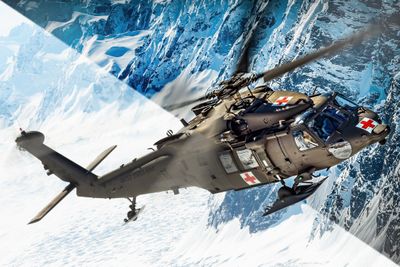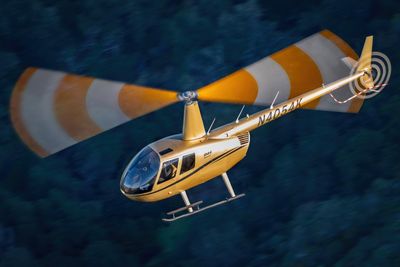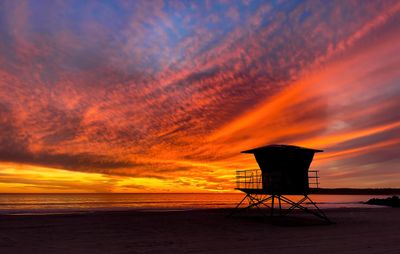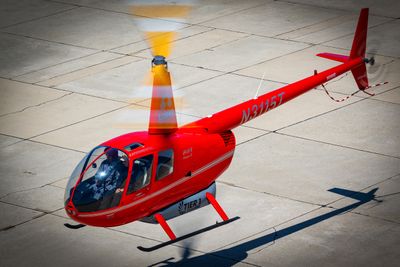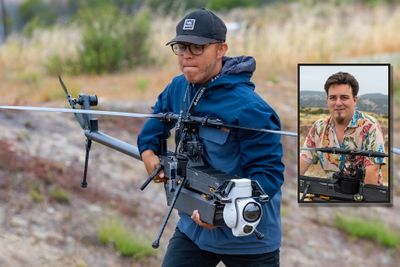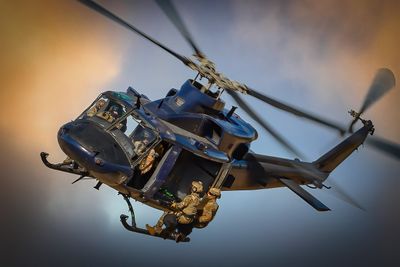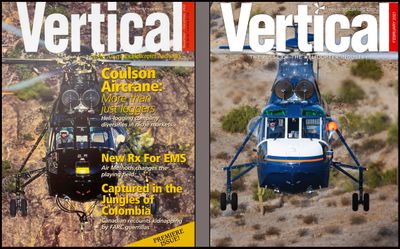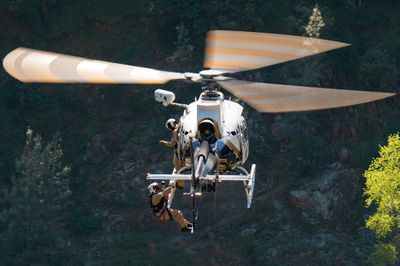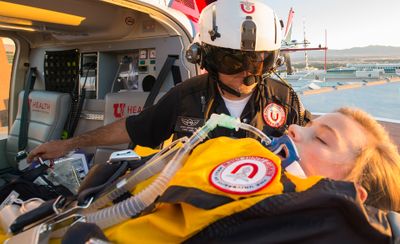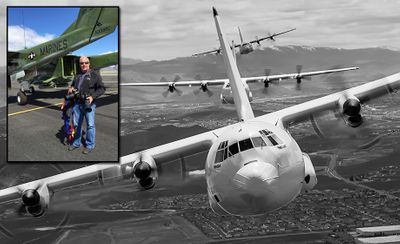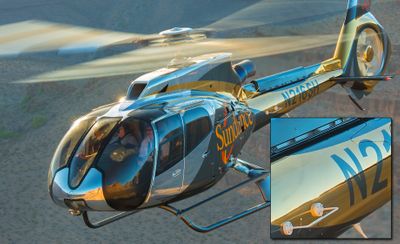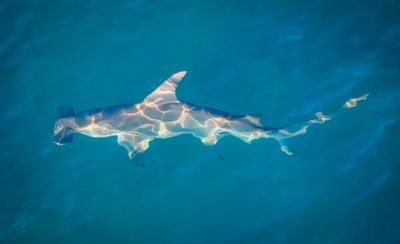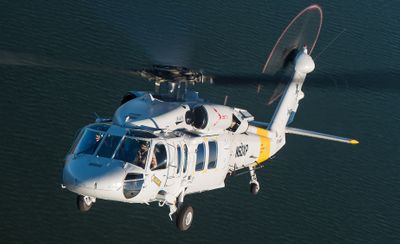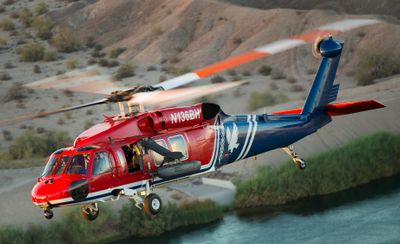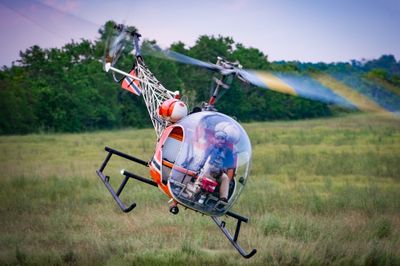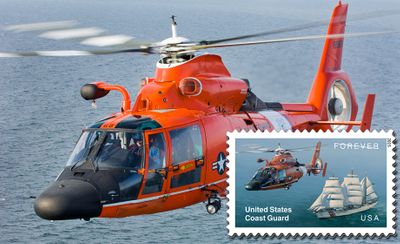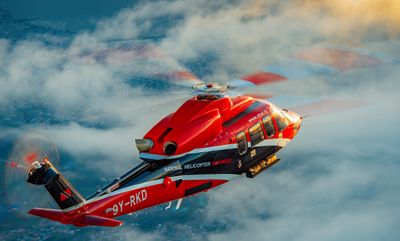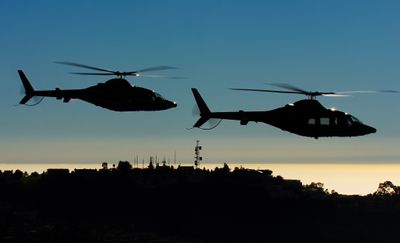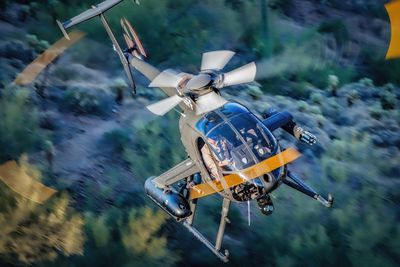Blog
by Dan Megna
In today's age of social media and digital storytelling, photography has become an integral part of our lives.
Aviation enthusiasts, in particular, have harnessed the power of creative editing to capture the beauty and dynamism of aircraft in flight like never before. Whether you're a seasoned aviation photographer or a novice looking to embark on this journey, creative editing can transform your aviation photos into distinctive works of art.
Before diving into the creative editing process, you'll need the right tools. Adobe Lightroom and Photoshop are popular choices. But there are also mobile apps such as Snapseed available to edit on the go. Start with the basics, learn the tools, and gradually explore advanced features as your skills grow.
If your camera allows it, shoot in RAW format! Unlike JPEG, RAW files capture all the data from your camera's sensor, offering greater flexibility in post-processing. This means you can often recover blown-out highlights or salvage underexposed shadows, which are crucial when dealing with the complex lighting conditions of aircraft in flight.
During editing, focus on adjusting exposure, contrast, and highlights to emphasize the aircraft's details. Don't be afraid to experiment with cropping and framing to create compelling compositions. Consider the rule of thirds, leading lines, and symmetry to make your photos visually engaging.
moreby Dan Megna
So, what do I mean by meaningful accidents?' Well, in the case of my photography, I'd describe it as having a mental 'visualization' of something I hope to capture with my camera and understanding the proverbial 'stars that must align' to have a shot at making it happen. Let's call it 'smart luck' or a serendipitous event.
An article on Psyche - a online digital magazine from Aeon that illuminates the human condition through psychology, philosophy and the arts describes it this way - 'We tend to think of serendipity as something that just happens to us, when actually it's a process of spotting and connecting the dots, to see bridges where others see gaps. 'Smart luck' or serendipity is about creating meaningful accidents – and making accidents meaningful!"
In this case, I was to be flying with Robinson Helicopter Company, (RHC), asked to capture marketing photos of a beautiful gold painted R44 Raven II with black accents. My camera platform was a turbine powered R66 operated by one of the seasoned RHC factory pilots.
We launched from their facility at the Torrance CA Airport shortly after sunrise as a 'flight of two.' I was shooting my mirrorless Nikon Z9/FTZ handheld, mated with my trusty Nikkor 70-200 f2.8 VR II lens.
moreby Dan Megna
It was seemingly a lifetime ago, (late 1980s), I was a young deputy sheriff assigned to my department's SWAT team. It was during this time I was fortunate to have met and worked alongside another deputy we all referred to as 'Gonzo.' He was a solid team mate and all around great guy. Everyone loved him!
On a December morning in 1987, our team was called to an 'active shooter' in an incorporated city in the county to provide a tactical element to address the situation. Before the day was over, one of our team mates was dead and two others wounded by the shooter's gunfire.
I'm not going to describe in detail how the incident evolved or was resolved. Lets just say the suspect was ultimately killed and many on the team sustained emotional as well as physical scars that would last a lifetime. Of the survivors, Gonzo was perhaps one of the most 'damaged.'
Gonzo withdrew from all of us. He was tormented with the pain from that horrible event, ultimately leaving the department. He and his family moved from the area and he was never heard from again. Gonzo went on to fight demons the rest of us never realized or entirely understood.
Fast forward to 2021/22, Gonzo and I finally reconnected. We had several phone conversations where we talked about what happened that December day, to him and the rest of us. But we also talked about wanting to reconnect and begin to heal from the horror all of us had been living with, but perhaps none more than Gonzo.
moreby Dan Megna
Admittedly, I quite often fall into the proverbial 'rut' when it comes to my photography. I suspect, because I'm most often working with my cameras, I seem to forget about them when I'm not working. I'm rarely 'inspired' to break out a camera, lenses and a tripod to do any 'recreational' shooting .
I'm pretty fortunate to live in an awfully pretty little beach town. So, last evening when I stepped out of the house for my usual late afternoon walk, the sun was still high in the sky and nearly completely obscured by clouds. I noticed, however, the clouds were very high in the atmosphere and as they spread out across the sky their edges were becoming wispy.
I've lived on the beach long enough to know when the sky is setting up for a potential 'show' at sunset. For a brief moment I had a conversation with myself - 'Dan, this is gonna be good. Run back and grab a camera and a tripod!'
Of course I didn't listen. I wasn't overly inspired and probably a little too lazy to go back. Instead, I continued on my walk, watching the sun slip below the gray cloud layer, across a sliver of clear sky before setting on the horizon.
Just as the sun disappeared, the magic began. Faint feathers of pink and orange began appearing across what was once drab gray clouds. Within minutes, the colors began to explode across the sky and I remember a sense of regret coming over me - 'DAMN, If I only had a 'REAL' camera!'
moreby Dan Megna
This past June I was contacted by a small aeronautical development group from Orange County, CA. Tier 1 Engineering explained they were several years into development of an electrically powered helicopter and were wanting photos for media promotion.
The aircraft is built upon the popular Robinson R44 Raven II air frame, however the traditional Lycoming piston engine has been replaced by an electric propulsion unit, (EPU).
The aircraft made its first flight in 2016. Two years later, an improved variant set a Guinness World Record for the farthest distance traveled by an electric helicopter - 30 nautical miles to an altitude of 800 feet with an average speed of 80 knots. Since that record breaking flight, the aircraft had undergone more engineering and modifications to improve performance.
I was invited to see the 3rd generation variant, now powered by the magniX electric propulsion unit (EPU). It first flew just a week before my visit. So of course, I was pretty excited to have been invited to witness and photograph such a revolutionary aircraft.
Arriving at the demonstration site I met Tier 1 president Glen Dromgoole. It was a very relaxed and informal setting as we walked to the aircraft for my initial introduction. The aircraft was beautiful. The bright red paint was flawless and highly polished. Not necessarily the condition I'd expect of an engineering prototype. Affixed to the belly of the aircraft was a large gray pod that was beautifully engineered and integrated with the R44 air frame. (I'm a bit embarrassed to not being entirely clear of the exact purpose of the pod but I believe it housed the EPU batteries).
moreby Dan Megna
It is said that chance encounters are important because they can have branching power. That is, they have the potential to have unforeseen knock-on impacts that dramatically alter the course of one’s life, sometimes opening up unexpected opportunities.
Such was the case for flight training icon Jerry Trimble. He couldn’t possibly have predicted how a chance meeting with a seemingly random individual in the 1970s would so dramatically affect the course of his life — and the lives of so many others in the years to come.
Those two paragraphs are from an article I penned in February '22 for Vertical magazine. If this at all whets your interest to learn the story of Jerry Trimble I invite you to enjoy the entire article that I've linked below.
https://verticalmag.com/features/jerry-trimble-helicopters-a-passion-for-instruction/
moreby Dan Megna
One of the really cool thing about some of my magazine and photography gigs is the opportunity to meet and spend time with some really interesting characters.
So, a month or so back, another writer for Vertical magazine, Brent Bergan, invited me to join him to help out with some photography for an article he was working up. It sounded interesting so I jumped at the chance. Besides, I hadn't seen Brent in several years and we've never had an opportunity to work together.
Prior to the shoot date, Brent sent me the draft of his article so I could better understand what the project involved. I would be photographing a new drone that resembled a traditional helicopter, although much smaller. Dubbed the Ghost 4, it reportedly possessed some pretty remarkable high tech capabilities and utilized artificial intelligence and targeted at the defense industry for battlefield surveillance.
While the technology and capabilities of this new drone certainly piqued my interest, it may have been learning about the company's young founder that was particularly interesting.
The company, Anduril Industries, was founded by Palmer Luckey, (inset photo), a twenty-something tech-guru known to favor flip-flops, cargo shorts and Hawaiian shirts as his standard business attire. Oh, did I mention he's also now worth several billion dollars
moreby Dan Megna
Special operation forces (SOF) are woven into the structure of national miltaries around the globe. Many are regarded as the most highly trained, well-equipped and formidable military operators in the world. They are valued for their ability to conduct unconventional and covert warfare missions beyond the scope of conventional military forces.
The Canadian Special Operations Forces Command (CANSOFCOM) is the element of the Canadian Armed Forces (CAF) responsible for SOF. Their stated mission: “To provide the Government of Canada with agile, high-readiness Special Operations Forces capable of conducting special operations in defense of Canada both at home and abroad.”
Under the CANSOFCOM umbrella are five distinct units: Joint Task Force 2 and Canadian Special Operations Regiment, warfighter units with assaulters/tactical operators; Canadian Joint Incident Response Unit, a chemical, biological, radiological and nuclear response; Canada Special Operations Training Center, a training center for all SOF personnel; and 427 Special Operations Aviation Squadron (427 SOAS), a precision tactical/utility airlift capability. A sixth entity is a headquarters providing command and control to all CANSOFCOM units.
moreBy Dan Megna
I'll admit, I've always been a bit of a 'sky geek.' Eclipses, meteor showers, Space Station fly overs... Heck, during the Hale-Bopp comet 20-something years ago I was up and out the door with my camera and tripod by 4am three or four days a week seeking new viewing areas around the county. Yeah, I guess I'm a a bit of a geek.
So, last month, I was fortunate to have tagged along with a MEDEVAC unit with the Alaska Army National Guard's 1st Battalion, 207th Aviation Regiment, for a week of training exercises. I went wearing my photojournalist hat for a project for Vertical magazine. It was here, however, Mother Nature treated me to an unexpected bonus; an opportunity to experience the Aurora Borealis or the Northern Lights!
The training began at the Guard's home base of Bryant Army Airfield in Anchorage. A few days later, we loaded up four UH-60 Black Hawks and a CH-47 Chinook and set off for Talkeetna to conduct the more advanced training evolutions. Some of which were conducted near 20,000 feet above the high glaciers on Denali.
Our base of operations was the Talkeetna Alaskan Lodge. It was still closed for the season, however, they opened up with a skeleton crew just to look after all of us for the week. It's a beautiful property perched high on a hill just south of town with incredible views to the west across the frozen Talkeetna river, to the mighty Alaska mountain range and the highest peak in North America, Denali.
moreby Dan Megna
Back in 2002, Mike and Linda Reyno first introduced Vertical magazine to the North American helicopter industry. The cover story for their premier issue was an operator profile on Coulson Aircrane, a Canadian operator specializing in logging and heavy lift work.
The photo chosen for the issue cover was captured by Mike Reyno; a black 'short-body' Sikorsky S-61N owned and operated by Coulson. The photo depicts the helicopter hovering above a 'load' as if performing a 'heavy lift' job. It was piloted that day by Michael Lighter, (leaning out/looking down through the bubble window).
I first began producing work for Vertical in 2004. While I've always enjoyed all the various assignments over the years, I've particularly enjoyed the operator profiles. So last fall when Mike Reyno suggested I produce an operator profile on another Canadian heavy lift operator; Helicarrier Helicopters, I jumped at the opportunity.
As is often the case, Mike provided me a point of contact within the company to facilitate interviews and on-site visits. In this instance, he connected me with Aaron Lighter, an experienced heavy lift helicopter pilot who is also an ownership partner in Helicarrier. Mike went on to explain an interesting connection between Aaron and the cover of Vertical's premier issue.
moreby Dan Megna
After four decades operating Bell UH-1F Hueys, (1981-1990) and UH-1H Super Hueys, (1990 to present), California’s state fire agency, the California Department of Forestry and Fire Protection, (CAL FIRE), has begun a long anticipated upgrade to their aviation program.
The Sikorsky S-70i FIREHAWK was chosen to carry on the agency's aerial firefighting legacy. A total of twelve FIREHAWKS will be acquired over the next couple years as the Hueys are phased out.
The first CAL FIRE HAWK was delivered in October 2019 and designated Copter 903. It was publicly showcased as a static display at the January 2020 HeliExpo. Today it is based at the CAL FIRE aviation headquarter facility at Sacramento McClellan Airport and serves as the first of what will be two maintenance spares for the new fleet.
The first fully operational CAL FIRE HAWK, (Copter 205), entered service in July 2020 with CAL FIRE’s Tehama Glenn Unit at Vina Helitack Base. The second fully operational FIREHAWK, (Copter 404), is assigned to the Columbia Helitack base.
With two more aircraft expected by early 2021, it is likely four CAL FIRE HAWKS will be operational for the upcoming fire season. It is projected the balance of the new fleet will be operational by spring/summer of 2022.
moreby Dan Megna
For twenty-something years I've always conducted business lugging a rather large DSLR/mirrorless camera kit. Regardless of where a project might take me, via airline, bush plane or driving myself, (always my favorite mode of transportation), I typically travel with up to three Nikon camera bodies, four to six lenses and a similar number of Nikon strobes, all neatly arranged in one of three Think Tank camera bags.
I've always enjoyed the process of working with my Nikon hardware. They have never failed me and the image quality is always top notch. In recent years, however, I'm having a tough time ignoring the incredible capabilities of the tiny cameras integrated into my iPhone. The evolution of the software has elevated the iPhone imaging capabilities, as well as many competing brands, to pretty remarkable levels.
But I consider myself a 'professional' photographer, and as such, shouldn't even consider the notion of shooting for a 'professional project' using my iPhone, right? Well, not so fast...
So I found myself in my local area in the San Diego backcountry with the good folks from San Diego Gas & Electric Aviation Services photographing a story for Vertical magazine. Of course, my trusty Nikon kit was strapped into the rear of the helicopter and my Nikon Z7 was hanging around my neck.
moreby Dan Megna
I have had the good fortune to work with Texas based Air Center Helicopters several times over the years. The company owner, Rod Tinney, is always one heck of a host and does whatever it takes to get great photos. So anytime an opportunity is presented to work with him and his company, I'm all over it
In this instance, it was a project for Vertical magazine; telling the story of how the company 'repurposed' the mighty Airbus H225 Super Puma, to fly a brand new mission for which it was never intended.
In a nut shell; the H225 had been used for many years all around the globe in the offshore oil and gas industry as a highly regarded people mover, shuttling workers from the mainland to oil platforms far offshore.
But since 2012, the aircraft had been under close scrutiny by aviation officials after a number of accidents, most resulting from a system or component failure associated with the aircraft's gearbox.
In spite of the aircraft manufacturer's efforts to engineer a 'fix' for the failures, the damage was already done. The aircraft fell out of favor by the oil and gas industry and most operators of the H225 were forced to mothballed their fleet in long term storage.
moreby Dan Megna
Utah might be my favorite destination for a road-trip getaway. It's an easy six or seven hour drive from my home in San Diego and it's a portal to so many beautiful outdoor destinations and always fabulous adventure. So needless to say I was overjoyed when a recent magazine project for Vertical 911 required I drive over and spend a week.
The focus of this project was Classic Air Medical, a helicopter air medical provider based in Utah. What I found so interesting, however, is where they have established bases. They presently have eleven bases in six western states; Utah, Wyoming, Colorado, Idaho, New Mexico and Arizona. But instead of following a business model embraced by similar operators of locating bases near large population centers or hospitals, Classic has taken a slightly different approach.
Classic's bases are in relatively small towns like Steamboat Springs CO, Moab UT, Riverton WY and Page AZ. But these small towns are magnets for all kinds of outdoor enthusiasts and adventure seekers.
While Classic performs the traditional air medical role of transporting patients to hospitals, they also bring the added capability of performing search and rescue, (SAR), which is particularly valuable to the communities they serve. In fact, Classic gives away up to two hours of free flight time to the local communities when requested by the local public safety agencies.
moreby Dan Megna
Any photographer worth his salt would agree - lighting is the critical element. Its direction, quality, color, intensity... It an essential ingredient of that big pot of creative soup for creating a distinctive image.
In the studio, a photographer has ultimate control over every aspect of lighting and can be very precise when creating an image. In the field however, controlling light is a different game. While it's certainly possible, it typically requires a little careful planning and perhaps a few assistants to manage light modifiers, reflectors, discs, scrims and of course portable lighting.
In air to air photography, control of lighting is, well.... pretty darn tough if not plain impossible. It just isn't practical. So instead, I have a few 'go to' tactics that have worked pretty well over the years and has allowed me, when the stars align, to capture some pretty cool frames. I say, 'when the stars align' because, sometimes, shit just doesn't your way. And perhaps that's a blog post for another day...
But one of my favorite tactics, especially when shooting in bright conditions with lots of contrast and busy backgrounds, is to shoot a side or front lit aircraft against a deep shadow. The accompanying photo was shot against a shaded canyon wall with the mid-morning sun, (approximately), 11 o'clock to the camera. The angle of the sun makes the high visibility rotor blades 'shine' and relatively slow 1/50 shutter really accentuates the spinning rotors.
moreby Dan Megna
In this dynamic world of aviation, I'm so fortunate to have all kinds of fabulous opportunities to photograph beautiful aircraft in some really amazing places. But it's important to consider the aviation industry is much more than just the flying machines. After all, they're just machines, right?.
When I drop in on an operation to begin working up a magazine article I immediately begin assessing how to best incorporate the human element into the storyline and the photography. While the machines are all shiny and sexy on the ground, they're really nothing special without people.
In any operation, it's all about the people; the flight crews, mechanics, ground support and administrative personnel... Then there's the world of air medical and search & rescue
Then there are those who have their lives improved and in many cases saved by the actions and teamwork of these crews. Often times these stories and associated photography are intensely compelling, adding a great deal of valuable context to illustrate the significance of the aircraft, the crew and the mission.
While these missions evoke great interest and emotion they're also quite personal. In the heat of the moment, the last thing medical crews or the patient want is some photographer sticking a camera in their face to get an 'action shot.' There are also serious privacy, ethical and safety issues that make those tactics inappropriate and typically unacceptable.
moreby Dan Megna
A few years back I had the good fortune to meet and work on a project with Shawn Adams, aka Rotor-Head. He and I were brought together by a mutual client as independent contractors to provide photography and video documentation during the testing of a new helicopter weapon system.
Shawn has a unique personality and skill set that was ideally well suited to the project. First, he's a fun and funny easy going guy and a hoot to be around. Which, considering we were trapped on a remote ranch in 'nowhere west Texas,' was a huge bonus. He's also a helicopter guy who's exceedingly comfortable in, on and around them and quite an accomplished pilot as well. He's also a talented cinematographer with a positive, high energy and creative 'can-do' attitude.
For this project, Shawn brought along a number of Pelican cases chock full of video cameras, all kinds of stabilizing equipment and also a number of drones with high definition 4K cameras. At the time, I had very little exposure to drones, especially those used for filming. I came to learn however, Shawn was one of the true pioneers, having operated drones for many years, even before their popularity exploded.
Throughout the project, Shawn and I worked side by side, sharing cabin space aboard helicopters during in-flight filming evolutions and inspiring or at least encouraging one another on the ground to perhaps try a camera angle that might be new or interesting.
moreby Dan Megna
As a photographer, it's my job to listen to a client's needs and develop a plan for successfully producing their concept. In this case the client, Coulson Aviation, operates three C-130 'Hercules' as firefighting air tankers. The aircraft were scheduled to be in Reno NV for training before the start of fire season. The client wanted me to photograph all three aircraft in flight, and specifically, in formation from a head on perspective.
I recognized this was gonna a bit of challenge for several reasons. First, 'Hercs' are big, each with a wingspan of over 132 feet! They're also fast, cruising at 180 to 200 knots. So, between the 'Hercs' massive size and the cruising speed, and the requirement I capture images from a head-on perspective, I knew was going to need a specialized aircraft as my camera platform.
I reached out to a couple fellow aviation photographers seeking suggestions on an appropriate aircraft. I was told of an OV-10 Bronco operated by the Cactus Air Force, a flying museum located nearby in Carson City.
The Bronco is a versatile Vietnam-era light attack and observation turbo-prop and has a couple unconventional design features making it ideal for photography. Behind the pilot station in the main fuselage is a small 'cargo' compartment configured with a rear tail cone which can be removed for flight. It also has twin tail booms connected by a horizontal stabilizer arranged as a high t-tail providing a nearly unobstructed rear view from the airplane. In Vietnam, small squads of paratroopers could be lined up inside. Once on target, they'd slide out on their butts and deploy their chutes. This day, those design characteristics together with the Bronco's performance capabilities, would make it well suited for this particular mission.
moreby Dan Megna
Every now and then when I'm on a project the stars align and I'm presented an opportunity to capture some really special images. This project a couple years back with Las Vegas NV based Sundance Helicopters was one such occasion.
The operator, which provides helicopter tours of Las Vegas and the Grand Canyon, was having a grand reopening. They had recently undergone a company wide re-branding that included a fantastic, completely remodeled customer reception facility and the introduction of new aircraft.
The first of what would eventually be over 20 Airbus EC-130s to be operated by Sundance had created quite a stir in the industry. It had been finished in an innovative gold and silver chrome exterior finish that contained over seven ounces of real silver. This was a proprietary finish developed specifically for this application to enhance the visual impact of the aircraft in the colorful Las Vegas and Grand Canyon environments.
I was to spend two days with the operator. The first day I spent meeting folks, conducting interviews and shooting photos around the the new facility and a glitzy evening grand re opening party. At the end of the day they asked what I would like to do the next day.
moreby Dan Megna
This was the second stop on my big adventure to Florida. After leaving Firehawk Helicopters, I made the three hour drive on the turnpike from Leesburg to the beaches of the Gold Coast and the city of Stuart. There I spent a couple days with the Martin County Sheriff's Office Aviation Unit.
The Martin County guys were terrific hosts and were excited to show me their county from the air. While the high end beach front homes were absolutely incredible, it was the abundance of wildlife in the clear, shallow water that I found amazing! We saw huge manta rays, bat rays, manatees, literally thousands of black tip and bull sharks... and then we saw this fella! He was just beyond the swim zone at the beaches and we estimated him to be nearly ten feet long.
So yeah, I got to fly millions of dollars worth of helicopters across some fabulous scenery and met some great guys, but seeing the hammerhead in that beautiful turquoise water was definately a highlight and somehow seemed to typify a Jimmy Buffett-ish picture postcard of Floridays.
moreby Dan Megna
It was short notice but I jumped at the opportunity when Vertical magazine called asking if I wanted to go down to Florida. It was late January so not having to endure Florida's oppressive summer heat and humidity made it all the more attractive.
I had two assignments, the first being Brainerd/Firehawk Helicopters in Leesburg, (an hour north west of Orlando). They had just celebrated twenty years operating civil Black Hawk helicopters for lifting work and firefighting, (and up until just two years ago the only civil Black Hawk operator in the U.S.). I needed to only round out photos for an article that I had already completed.
When I rolled into Firehawk I was met by Alex Anduez, the company's director of experimental test flight. We had worked together on two previous projects so we we were able to dispense with too many formalities and instead quickly put the photo plan into action.
I met up with Firehawk's president Bart Brainerd who had granted us the freedom to pretty much put any machines into the air that we wanted. And with direct operating costs of a Black Hawk placed at $3900.00 per hour, I understood how this was an awfully generous opportunity.
We flew two photo shoots that day. The first was a formation of two Black Hawks painted in the familiar company red, white and blue colors and a third aircraft, an AS350B3 as my camera platform. The afternoon flight we launched two other Black Hawks; one a freshly overhauled machine painted in a blue over white scheme and presently on the market. The second machine, the one in the photo, is known as Alex's baby. And his attachment to this machine was made abundantly clear. It's maintained in it's original military configuration and paint and primarily used by Firehawk for research and development, most often with defense contractors working on military projects.
moreby Dan Megna
I felt awfully privileged to have been asked to work up this story for Vertical 911. This was to be a 'proof of concept' project, taking a standard utility/firefighting Black Hawk helicopter and quickly re configuring it into an armed medium attack helicopter, (the article can be found in the 2017 HeliExpo edition of Vertical 911).
After a leisurely 2 1/2 hour drive from my place in San Diego, I arrived at the project headquarters, a rather isolated, nondescript hangar at the Yuma AZ International Airport. Inside, a brightly painted civil Black Hawk provided by Firehawk Helicopters was in the early stages of the transformation. Teams of engineers from over a dozen aerospace and engineering companies and weapon manufacturers were quietly going about their business.
I was admittedly a bit tentative wondering how long it would be before some project manager would see my camera bag and confront me. But to my surprise I was warmly welcomed and given a comprehensive brief as to what was happening and schedule of the week's events. By early afternoon the project manager tracked me down to tell me, in spite of the elevated work tempo to prepare the aircraft, they were planning to launch the Black Hawk later in the day for a dedicated air to air photo shoot for me! YEA!
moreby Dan Megna
Typically when I head out on a photo gig I've already had several phone conversations with all parties involved to arrange and ensure the logistical support I need to make my visit a success. But sometimes, even the best thought out plans hit a snag and require creative thinking on the fly. This was one such instance...
It was fall in the Colorado Rockies and I was given the assignment to photograph an Airbus H125 that was configured with a new innovative airflow management system, the FastFin from BLR Aerospace. The product had just received its FAA certification and Vertical magazine already had an article ready to go from another writer, (The story can be found in the Dec 2016/Jan 2017 of Vertical magazine). My job was just to get photos that reflected the aircraft flying high in the mountains. BLR also requested video for their marketing so I invited my video guru, Shawn Adams to come along.
The aircraft was based in Gunnison CO however the pilot agreed to meet us anywhere in the state that might be more convenient. You see, I had to arrange a camera aircraft for us to shoot from and the closest I could find was many miles north in Steamboat Springs CO. So we agreed, Shawn, the camera helicopter and I would meet in the middle near Glenwood Springs and the H125 would rendezvous there.
moreby Dan Megna
In working as a journalist in the helicopter industry I have the opportunity to meet all kinds of interesting folks. Some have been around since the earliest days of the industry. Others have have their fingerprints on significant aviation milestones. Then there are those who have just held a love of flying since childhood and have gone on to pursue their dreams. And through it all, they've created a highly successful business in the industry they love. These folks are inspiring and their stories are some of the best.
Case in point is Bob McCoy, president of Westwind Helicopters of Santa Fe TX who today operate more than two dozen helicopters, including fourteen Bell 407s and two Sikorsky S-76s, in support of the offshore oil and gas industry.
Bob's love of aviation goes back to his youth and hanging out with his grandpa who was a mechanic on ag-spray aircraft at a nearby airport. By seventeen, Bob earned his fixed wing license and spent his free time honing his skills in the air. In the early 1980, he embarked on a his first professional career working with the oil and gas industry on offshore rigs in the Gulf of Mexico.
It was around this time Bob's aviation interests turned to helicopters. He purchased an old Bell 47G which was in dire need of restoration. Over the next year he personally rebuilt the entire machine which allowed him to earn his ATP and ultimately his helicopter rating. He then began flying wildlife/cattle management jobs and agriculture spray work throughout south Texas while off-shift with his oil and gas job.
moreby Dan Megna
Imagine this: You're on a work trip in Puerto Rico when a wealthy businessman generously offers you the use of his executive Bell 427 helicopter to go exploring the coastlines at sunset. It's the stuff dreams are made of, and I feel exceedingly fortunate, this dream became a reality.
I was in Puerto Rico in May 2016 working up a project for Vertical magazine. The principal of the company I was working with was a close personal friend of this businessman and coincidentally also looked after his personal helicopter. During lunch one afternoon, this businessman unexpectedly joined us. He was very friendly and interested in hearing about the magazine project. At the conclusion of lunch, the gentleman offered up his helicopter and his pilot and suggested we go sightseeing that afternoon to enjoy the beaches of Puerto Rico
Puerto Rico, often referred to as the "Island of Enchantment," boasts some of the most beautiful beaches in the world. From the powdery sands of Flamenco Beach to the secluded charm of Playa Negra, there's no shortage of breathtaking coastal spots to discover. But, experiencing these natural wonders from a luxury helicopter takes the adventure to an entirely new level.
moreDan Megna
The 'digital age' and the Internet has become a double edge sword for many aspects of our everyday and professional lives. As photographers, 'digital' has stream lined our workflow, reduced costs, increased efficiency and enables us to quickly and easily share our work with clients, potential clients, friends and family.
But along with these seemingly wonderful advantages, there are several down sides that can be very problematic for photographers. Something as innocent and well-intentioned as sharing an image online or even with someone individually in a professional capacity, can lead to some unexpected consequences. Here's one of my experiences...
In 2006 I did an advertising photo shoot for a client with the U.S. Coast Guard, (USCG), in Atlantic City NJ. The USCG crews and public affairs people were absolutely fabulous to work with and I came away with some terrific images. As a way of saying 'thanks' I forwarded a few sample images to the USCG public affairs office who had assisted me. I asked for and was assured the images would only be used within the USCG organization and not shared with any outside commercial entities.
Fast forward nine years to the summer of 2015. The USCG was celebrating its 225th anniversary and the U.S. Postal Service, (USPS), issued a special stamp to commemorate the event. Over morning coffee I was surfing the online news of the day and clicked on the headline. When I opened the article and saw the sample of the stamp I was kinda shocked. The helicopter incorporated to the stamp looked awfully familiar. I pulled my original file, (above), and compared it with the stamp. I was pretty confident it was in fact my image that had been used to create the stamp.
moreby Dan Megna
It was June 2015 and I was proposed a dual purpose trip, sponsored by Sikorsky and Vertical magazine, to visit National Helicopters down in the Caribbean island nation of Trinidad & Tobago. Sikorsky was hoping to capture some in-flight photos of the first S76D model to enter service. Vertical magazine was asking for an article to showcase the operator and the aircraft.
Arriving at the airport in Trinidad and entering customs, I sensed something was up. When the customs inspector asked what my business was on the island, and I mentioned I was there to visit a certain name at National Helicopters, it was if the VIP light went on over my head. They even carried my bags to the waiting town car at the curb.
Anyway, everyone at National Helicopters were total pros and seemingly happy to see me. The Sikorsky contingent; the marketing and sales folks, were also very welcoming. We discussed the 'plan' for what we'd hope to accomplish over the next few days. At the conclusion of the meeting, it seemed were all off to a fabulous start.
Over the next day or so we managed to do a couple air to air photo shoots with the S76Ds; a single aircraft shoot followed by a two aircraft formation. Back at the base, in looking over the photos I had, I wasn't terribly happy. There were some beautiful frames, especially the two aircraft in formation. But I knew we could do better and I knew lighting was the key.
moreBy Dan Megna
It was a sparkling early winter day in December 2004 when Neville 'Ned' Dawson invited me to join him on a photo shoot. He had traveled to my home town of San Diego CA from his place in New Zealand for an opportunity to photograph two Bell 430s.
I had known Ned for several years prior to this project and I had already produced a couple editorial projects for his magazine, HeliOps. At the time, HeliOps was the first of what has since become a handful of magazines covering the global helicopter industry and placed a heavy emphasis on a rather dramatic style of photography.
A local operator owned one of the 430s and had a business relationship with the owner of the other. The concept was take both aircraft out to the coastline and photograph them against the beautiful beaches.
About this time, another small publishing group based in Canada was making inroads into the helicopter industry. They were pursuing a similar model for their magazine, Vertical, and placed a high priority on articles written by industry professionals and dramatic photography that showcased the aircraft.
As a result of my exposure in HeliOps, the publishers of Vertical had become familiar with my writing and my photography and extended me an opportunity to produce work for them as well. While that didn't sit too will with Ned, we managed to remain friends and associates and I have to give him credit for my early opportunities in this industry.
moreby Dan Megna
The MD530G helicopter is an impressive piece of machinery. Known for its agility, speed, and versatility, this helicopter is a favorite among military and law enforcement agencies worldwide. In my flying career I feel exceedingly fortunate to have spent several thousand hours piloting the amazing and capable MD530F, (an earlier and similar incarnation of the 'G'), as well as several of its relatives in the iconic MD Helicopter line.
But what made this particular shoot a unique opportunity was the dual weapon systems that had been installed, taking the MD530G’s mission capabilities to a whole new level. And at the conclusion of the photo sortie, I was then given an opportunity to fly this little bird which is a story for another day.
Anyway, the weapon systems aboard the MD530G consisted of rocket pods and a .50 caliber machine gun mounted outboard on two stub-wings. This configuration was intended to showcase the MD530G's capacity to perform a wide range of military missions, from air support and reconnaissance to combat operations. This prototype was a testament to cutting-edge engineering and innovation, and capturing it on camera was a thrilling experience.
For this particular shoot I chose early morning, hoping to capture the helicopter flying low and fast across rugged desert terrain, hoping to evoke a sense of surprise of the little bird emerging from the darkness.
moreby Dan Megna
A little time travel back to August 2004. I was still working as a law enforcement pilot flying MD500 series helicopters when a new acquaintance offered to bring his Bell 412 and Bell 407 helicopters to our facility as a demo of sorts. He proposed exposing our pilots and command to these larger, more capable aircraft.
Rod Tinney, was/is the president of Texas based Air Center Helicopters. At the time he was in San Diego working contracts with the U.S. Navy. As I recall I was brand new creating work for a relatively new helicopter industry magazine - Vertical magazine. I somehow realized Rod was in town and reached out to propose an article for Vertical.
Rod and I eventually met up. He was highly enthusiastic about supporting a story of his company and their work with the military. He managed to pull all the right strings with the military brass and got me embedded with his flight crews flying all sorts of crazy missions with the Navy offshore with destroyers during sea trials! Since then Rod has been highly supportive of other exclusive story opportunities that showcased Air Center Helicopters.
Anyway, the accompanying photo in this post of one of Rod's Bell 412 was one of the first images I shot which I'd eventually submit for one of my first articles for Vertical magazine - A story about Air Center Helicopters and their contracts supporting the U.S. Navy offshore. This particular frame was shot during one of the demo flights for my department command staff.
more
